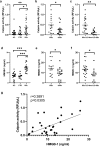Increased serum calpain activity is associated with HMGB1 levels in systemic sclerosis
- PMID: 32393322
- PMCID: PMC7216546
- DOI: 10.1186/s13075-020-02195-y
Increased serum calpain activity is associated with HMGB1 levels in systemic sclerosis
Abstract
Background: Systemic sclerosis (SSc) or scleroderma is an intractable autoimmune disorder that affects multiple organs. The objectives were to investigate clinical correlations of serum calpain activity and high mobility group box 1 (HMGB1) levels with immunological and clinical traits.
Methods: A total of 31 patients with SSc, 20 age- and gender-matched healthy control subjects (HC), and 10 patients with other connective tissue diseases (CTD) were recruited in the study. We measured serum calpain activity and HMGB1 levels and analyzed the datasets (GSE40839, GSE48149, GSE76808, GSE81292, GSE33463, and GSE58095) from Gene Expression Omnibus (GEO) database to explore the potential mechanism by which calpain exerts its function through bioinformatics methods.
Results: Serum calpain activity was significantly increased in patients with SSc compared with those in HC and in patients with CTD and was correlated with serum HMGB1 levels, modified Rodnan skin score, erythrocyte sedimentation rate, mean platelet volume, and plateletcrit. Notably, serum calpain activity and HMGB1 levels in SSc patients with interstitial lung disease (ILD) were significantly higher than those in SSc patients without ILD. Serum calpain activity and HMGB1 levels could be the independent risk factors for SSc-ILD and novel biomarkers in patients with SSc.
Conclusion: This is the first study that reports increased serum calpain activity and the correlation between calpain and HMGB1 in patients with SSc or SSc-ILD. The serum calpain activity and HMGB1 levels may serve as measures of ILD in patients with SSc. Also, calpain and HMGB1 could be potential therapeutic targets for patients with SSc or SSc-ILD in the future.
Keywords: Calpain; HMGB1; Interstitial lung disease; Microarray analysis; Systemic sclerosis.
Conflict of interest statement
The authors declare that they have no competing interests.
Figures





Similar articles
-
Myeloid cell-specific deletion of Capns1 prevents macrophage polarization toward the M1 phenotype and reduces interstitial lung disease in the bleomycin model of systemic sclerosis.Arthritis Res Ther. 2022 Jun 21;24(1):148. doi: 10.1186/s13075-022-02833-7. Arthritis Res Ther. 2022. PMID: 35729674 Free PMC article.
-
Etiology, Risk Factors, and Biomarkers in Systemic Sclerosis with Interstitial Lung Disease.Am J Respir Crit Care Med. 2020 Mar 15;201(6):650-660. doi: 10.1164/rccm.201903-0563CI. Am J Respir Crit Care Med. 2020. PMID: 31841044 Free PMC article.
-
[Expression and clinical significance of plasma exosomal miR-34-5p and miR-142-3p in systemic sclerosis].Beijing Da Xue Xue Bao Yi Xue Ban. 2023 Dec 18;55(6):1022-1027. doi: 10.19723/j.issn.1671-167X.2023.06.010. Beijing Da Xue Xue Bao Yi Xue Ban. 2023. PMID: 38101783 Free PMC article. Chinese.
-
Interstitial Lung Disease in Patients With Systemic Sclerosis: Toward Personalized-Medicine-Based Prediction and Drug Screening Models of Systemic Sclerosis-Related Interstitial Lung Disease (SSc-ILD).Front Immunol. 2020 Sep 4;11:1990. doi: 10.3389/fimmu.2020.01990. eCollection 2020. Front Immunol. 2020. PMID: 33013852 Free PMC article. Review.
-
Serum concentration of surfactant protein D in patients with systemic sclerosis: The potential marker of the interstitial lung disease severity.Best Pract Res Clin Rheumatol. 2018 Aug;32(4):541-549. doi: 10.1016/j.berh.2019.01.005. Epub 2019 Feb 14. Best Pract Res Clin Rheumatol. 2018. PMID: 31174823 Review.
Cited by
-
Mediators of systemic sclerosis-associated interstitial lung disease (SSc-ILD): systematic review and meta-analyses.Thorax. 2023 Aug;78(8):799-807. doi: 10.1136/thorax-2022-219226. Epub 2022 Oct 19. Thorax. 2023. PMID: 36261273 Free PMC article.
-
Myeloid cell-specific deletion of Capns1 prevents macrophage polarization toward the M1 phenotype and reduces interstitial lung disease in the bleomycin model of systemic sclerosis.Arthritis Res Ther. 2022 Jun 21;24(1):148. doi: 10.1186/s13075-022-02833-7. Arthritis Res Ther. 2022. PMID: 35729674 Free PMC article.
-
HMGB1 as a therapeutic target in disease.J Cell Physiol. 2021 May;236(5):3406-3419. doi: 10.1002/jcp.30125. Epub 2020 Oct 26. J Cell Physiol. 2021. PMID: 33107103 Free PMC article. Review.
-
Proteomic profiling of extracellular vesicles in synovial fluid and plasma from Oligoarticular Juvenile Idiopathic Arthritis patients reveals novel immunopathogenic biomarkers.Front Immunol. 2023 Apr 27;14:1134747. doi: 10.3389/fimmu.2023.1134747. eCollection 2023. Front Immunol. 2023. PMID: 37205098 Free PMC article.
-
Identification of serum exosome proteins in systemic sclerosis with interstitial lung disease by aptamer proteomics.Arthritis Res Ther. 2025 Jul 10;27(1):146. doi: 10.1186/s13075-025-03595-8. Arthritis Res Ther. 2025. PMID: 40640963 Free PMC article.
References
-
- Mostmans Y, Cutolo M, Giddelo C, Decuman S, Melsens K, Declercq H, Vandecasteele E, De Keyser F, Distler O, Gutermuth J, et al. The role of endothelial cells in the vasculopathy of systemic sclerosis: a systematic review. Autoimmun Rev. 2017;16:774–786. doi: 10.1016/j.autrev.2017.05.024. - DOI - PubMed
Publication types
MeSH terms
Substances
LinkOut - more resources
Full Text Sources
Medical

